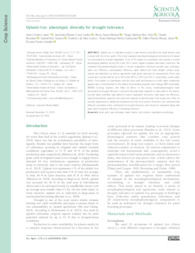Upland rice: phenotypic diversity for drought tolerance.
Upland rice: phenotypic diversity for drought tolerance.
Author(s): LANNA, A. C.; COELHO, G. R. C.; MOREIRA, A. S.; TERRA, T. G. R.; BRONDANI, C.; SARAIVA, G. R.; LEMOS, F. da S.; GUIMARÃES, P. H. R.; MORAIS JÚNIOR, O. P.; VIANELLO, R. P.
Summary: Upland rice is cultivated mostly in Latin America and Africa by small farmers and in areas with risk of dry spells. This study evaluated morphophysiological mechanisms of upland rice associated to drought adaptation. A set of 25 upland rice genotypes were grown in a plant phenotyping platform during 2015 and 2017 under regular irrigation and water restriction. We evaluated morphophysiological traits in shoots (vegetative structures growth, gas exchange, water use efficiency, carboxylation efficiency, water status) and roots (length, surface area, volume and diameter), as well as agronomic traits (grain yield and its components). There was a reduction in grain yield by up to 54 % and 58 % in 2015 and 2017, respectively, under water deficit. Five upland rice genotypes with the best yield performances in both water treatments applied were recommended to the upland rice-breeding program: Bico Ganga, BRS Esmeralda, BRSMG Curinga, Guarani, and Rabo de Burro. In this study, morphophysiological traits associated to drought tolerance concerned the plant high capacity to save water in the leaves, low leaf water potential, high ability to reduce vegetative structures, high water use efficiency, high photosynthetic capacity, and improved capacity to absorb water from drying soil, either by osmotic adjustment or additional investment into the root system. Therefore, we concluded that different secondary traits contributed to drought tolerance and should be evaluated along with grain yield to improve efficiency of breeding selection.
Publication year: 2021
Types of publication: Journal article
Unit: Embrapa Rice & Beans
Observation
Some of Embrapa's publications are published as ePub files. To read them, use or download one of the following free software options to your computer or mobile device. Android: Google Play Books; IOS: iBooks; Windows and Linux: Calibre.
Access other publications
Access the Agricultural Research Database (BDPA) to consult Embrapa's full library collection and records.
Visit Embrapa Bookstore to purchase books and other publications sold by Embrapa.

